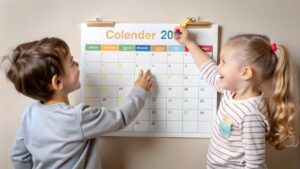The Education Blog

How to Identify and Adapt to Your Child’s Learning Style
Ever feel like your child just isn’t connecting with a lesson, even though you’ve explained it a dozen different ways? You’re not alone — and it’s not a failure on your part or theirs. It’s often a simple case of learning style mismatch.
Every child learns in their own unique way. Some absorb information through visuals, others through sound, and some need to do something to truly grasp it. As a homeschooling parent, the beauty is that you’re not bound by one teaching method. You’ve got the flexibility to personalise your approach — but first, you need to know what works best for your child.
In this guide, we’ll explore how to identify your child’s learning style, what each type looks like in real life, and how you can adapt your homeschool methods to suit them. By doing this, you’ll make learning more effective — and a lot more enjoyable.
What Are Learning Styles?
Understanding the Basics
A learning style is simply the way a person prefers to take in, process, and remember new information. While no two learners are exactly the same, most children tend to favour one of the following.

- Visual learners: Learn best through images, charts, and spatial understanding.
- Auditory learners: Thrive on spoken word, music, and verbal instruction.
- Kinesthetic learners: Learn by doing — through movement, touch, and physical activity.
- Reading/Writing learners: Prefer information through text-based content, note-taking, and written expression.
These aren’t rigid boxes. Many children are multimodal — they use a mix of styles but still show a clear preference.
Why Learning Styles Matter in Homeschooling
Traditional classrooms often teach to the middle — using standardised methods that may only suit a handful of students. In contrast, homeschooling gives you the chance to build a truly personalised homeschool environment tailored to how your child learns best.
Benefits of Teaching to Learning Styles:
- Better engagement: Kids stay interested when material makes sense to them.
- Fewer frustrations: Lessons go smoother when the method matches their strengths.
- Deeper understanding: Concepts stick when presented in a preferred format.
- More confidence: Children feel successful — and that builds motivation.
By recognising learning preferences, you’re not just teaching — you’re empowering.
How to Observe Your Child’s Learning Preferences
You don’t need a formal learning style assessment to start noticing how your child processes the world. Simply watch them during everyday tasks.
Ask Yourself:
- When solving a puzzle, do they draw pictures in their mind or talk their way through?
- Do they enjoy reading instructions, or do they skip ahead and start doing?
- Do they remember better when you tell them something or when they write it down?
- How do they react to visuals like maps, diagrams, or mind maps?
Keep notes over a week or two. Patterns will emerge.
You can also try online quizzes (like the VARK questionnaire), but these work best alongside your own observations and instincts.
The Visual Learner
Signs You’re Teaching a Visual Learner:
- They love colours, patterns, and spatial layouts.
- They remember what they see more than what they hear.
- They benefit from visual aids like charts, diagrams, and videos.
How to Support Them:
- Use colour-coded folders or flashcards.
- Incorporate mind maps, timelines, and flowcharts.
- Let them draw their understanding, like sketching historical scenes or science cycles.
- Watch educational documentaries together.
If your child thrives on images, consider exploring techniques discussed in visual learners homeschool strategies that work for further inspiration.
The Auditory Learner
Signs You’re Teaching an Auditory Learner:
- They talk things out to process information.
- They remember songs, rhymes, and oral instructions well.
- They often read aloud or “talk to themselves” while working.
How to Support Them:
- Read texts aloud together.
- Use audiobooks and educational podcasts.
- Encourage oral summaries of what they’ve learnt.
- Create songs or rhymes to remember facts.
Background music can also be helpful — just make sure it isn’t distracting.
The Kinesthetic Learner
Signs You’re Teaching a Kinesthetic Learner:
- They struggle to sit still and focus for long periods.
- They learn better through movement and hands-on tasks.
- They enjoy building, acting, or experimenting.
How to Support Them:

- Create physical games.
- Allow frequent movement breaks or use standing desks.
- Turn learning into roleplay, dance, or physical games.
- Let them create models or act out stories.
This learning style thrives in environments that embrace active learning. You might enjoy tips from kinesthetic homeschooling teaching through movement for more ideas.
The Reading/Writing Learner
Signs You’re Teaching a Reading/Writing Learner:
- They love books, journaling, and research.
- They take detailed notes and enjoy self-guided study.
- They prefer written tests over oral presentations.
How to Support Them:
- Offer plenty of reading material — both fiction and non-fiction.
- Use workbooks, printable planners, and checklists.
- Encourage creative writing, essays, and independent projects.
- Let them teach back a topic in writing.
A strong grasp of written language opens doors across every subject, so this preference often leads to well-rounded success.
Adapting Your Homeschool Methods Without Overcomplicating
You might be wondering “What if I have more than one child, and they all learn differently?”
You’re not alone — and yes, it’s manageable.
Here’s How:
- Rotate teaching styles within lessons — combine visuals, movement, and discussion.
- Give choice when assigning tasks — let your child decide whether to write, draw, or present.
- Use group work to mix styles — visual learners can design posters, auditory ones can present, kinesthetic learners can build models.
- Plan flexibly — if one approach isn’t clicking, change it up.
You don’t need to overhaul your entire routine. Start with small shifts, watch how your child responds, and adjust as you go.
The Power of Personalisation in Learning
At the core of personalised homeschooling is the belief that education isn’t about forcing a child into a mould. It’s about discovering how they learn — and using that knowledge to unlock their potential.
Children who feel understood learn better. They participate more. They take ownership of their progress.
This isn’t just about better grades — it’s about building lifelong learners.
Tune In, Then Teach
Homeschooling gives you the incredible opportunity to tailor education to your child’s unique rhythm. By identifying and embracing their learning style, you’re not only helping them understand what they’re learning — you’re helping them discover how they learn.
Whether your child lights up at a diagram, hums their way through maths facts, or builds volcanoes in the kitchen, learning becomes something they look forward to — not something they have to endure.
So, what’s next? Start observing. Take notes. Try one new method this week that matches their style. And remember — your curiosity about how they learn is already one of your greatest teaching tools.









